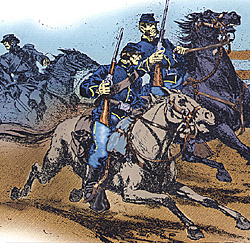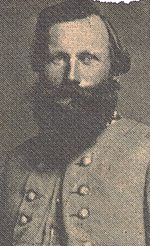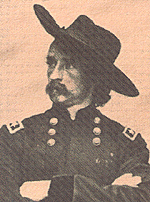 As Robert E. Lee moved his Army of Northern Virginia northward towards central Pennsylvania, portions of his cavalry division under J.E.B. Stuart slipped across the path of the Union Army of the Potomac. In a series of raids, Stuart's men captured several Union wagon trains. However, they were not in position to effectively screen Lee's advance or to provide intelligence on the movements of the Federal army.
As Robert E. Lee moved his Army of Northern Virginia northward towards central Pennsylvania, portions of his cavalry division under J.E.B. Stuart slipped across the path of the Union Army of the Potomac. In a series of raids, Stuart's men captured several Union wagon trains. However, they were not in position to effectively screen Lee's advance or to provide intelligence on the movements of the Federal army.
As Stuart turned and headed north in an effort to link with Lee, Union cavalry commander Alfred Pleasonton issued orders to his divisions to fan out and cover a wide swath in Maryland and Pennsylvania, looking for General Ewell's Rebel infantry that had passed through the area only days before. Kilpatrick's division was on the Union right flank.
Instead of finding Ewell, they would stumble into J.E.B. Stuart's veteran cavalry.
Shortly before 10 a.m. on June 30, 1863, the rear guard of the Union 18th PA Cavalry spotted Rebel cavalry vedettes about 3 miles southwest of the sleepy Pennsylvania town of Hanover.
In the ensuing exchange of small arms fire, a Rebel cavalryman died and several more were wounded. Shortly thereafter, a small group of around 25 men of Co. G of the 18th PA were captured by the 13th VA from Chambliss' Brigade, the vanguard of Stuart's cavalry division.
 South of Hanover near Perinville, the rest of the 18th PA:s column was struck and split in two by the 2nd NC Cavalry. Survivors of the 18th retired in disorder through the town of Hanover just as Rebel horse artillery arrived, unlimbered, and opened up on the retreating 18th PA. As the 2nd NC occupied the town in the wake of the fleeing 18th PA, the 5th NY Cavalry wheeled into position and attacked the Rebel flank in the city streets, forcing the Tarheels to abandon their brief hold on the town.
South of Hanover near Perinville, the rest of the 18th PA:s column was struck and split in two by the 2nd NC Cavalry. Survivors of the 18th retired in disorder through the town of Hanover just as Rebel horse artillery arrived, unlimbered, and opened up on the retreating 18th PA. As the 2nd NC occupied the town in the wake of the fleeing 18th PA, the 5th NY Cavalry wheeled into position and attacked the Rebel flank in the city streets, forcing the Tarheels to abandon their brief hold on the town.
As more of Chambliss' men (and Stuart [at right]) arrived on the scene, they were met by additional Federals near the Carl Forney farm. Almost surrounded in the confused fighting, Stuart and his staff made their escape across country through the hedges bordering the country lane.
Hearing the sound of gunfire, Judson Kilpatrick raced the rest of his division towards Hanover, with Kilpatrick's mount dying from the severe fury of the ride. Kilpatrick began to deploy his men in and around Hanover, even barricading some streets with barrels, farm wagons, dry goods boxes, and anything else that might provide some cover. Shortly before noon, fighting at the Carl Forney farm ceased as the Rebels broke off contact.
When Fitzhugh Lee arrived, Stuart moved his men into a new position on a ridge extending from the Keller Farm southwest of Hanover to the Mount Olivet Cemetery southeast of town. Meantime, Kilpatrick moved brigades of Farnsworth and Custer (at right) around to form a better defensive perimeter and brought up his artillery, itching for a fight.
 An artillery duel ensued for the better part of two hours as Stuart and Kilpatrick's guns lobbed occasional shells at each other. Shells and fragments blasted holes in several houses in town, and narrowly missed killing a Mrs. Winebrenner and her daughter who had just left their balcony when a shell came hurtling across it. The cannonade ceased around 2 p.m. as General Wade Hampton arrived escorting an estimated 200 captured Union supply wagons.
An artillery duel ensued for the better part of two hours as Stuart and Kilpatrick's guns lobbed occasional shells at each other. Shells and fragments blasted holes in several houses in town, and narrowly missed killing a Mrs. Winebrenner and her daughter who had just left their balcony when a shell came hurtling across it. The cannonade ceased around 2 p.m. as General Wade Hampton arrived escorting an estimated 200 captured Union supply wagons.
Leaving the wagons 2 miles south of town under heavy guard, Hampton brought the rest of his men into position to the extreme right of Stuart's line. Custer's dismounted 6th MI then moved forward to within 300 yards of Chambliss' line. Flanked and losing 15 men as prisoners, the 'Wolverines' tried again, and succeeded in securing the Littlestown-Frederick Road, opening a line of communication with the Union XII Corps.
Stuart and Kilpatrick made no further aggressive moves, and both sides exchanged a series of skirmishes and probing actions. Stuart held his position throughout the afternoon, repeatedly sending out scouts to try to locate Lee's main army. Protecting his captured wagons, Stuart slowly withdrew to Dover, PA, still trying to locate Early or Ewell and their infantry, thinking them to be northeast towards the Susquehanna River. Arriving in Dover the morning of July 1 (while Heth's Division of the Confederate army collided with Buford's Union cavalry division at Gettysburg), Stuart finally learned that Jubal Early of Ewell's Corps had left York and was heading back to the southwest as the army concentrated.
Stuart headed for Carlisle, continuously sending out officers to search for the infantry columns. Reaching Carlisle hoping to find Ewell, Stuart instead found nearly 3,000 state militiamen from Pennsylvania and New York occupying the town.
The fighting at Hanover, and the brief encounter at Carlisle, slowed Stuart considerably in his attempt to rejoin the main army and locate Lee. The 'eyes and ears' of the Army of Northern Virginia had failed Lee.
More Hanover, PA: June 30, 1863
- Introduction and Historical Background
Losses at Hanover
Scenario
Large Scenario Map (very slow: 218K)
Scenario OOB (slow: 104K)
Back to The Zouave Number 54 Table of Contents
Back to The Zouave List of Issues
Back to Master Magazine List
© Copyright 2001 The American Civil War Society
This article appears in MagWeb (Magazine Web) on the Internet World Wide Web.
Other military history articles and gaming articles are available at http://www.magweb.com